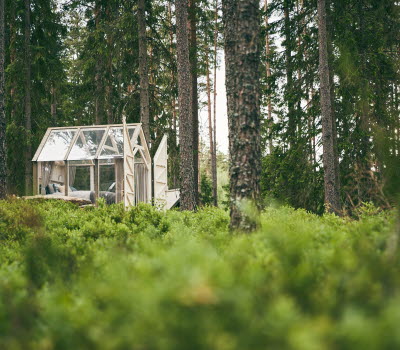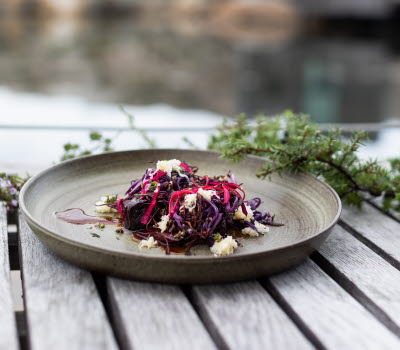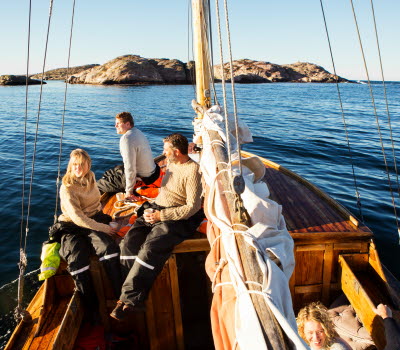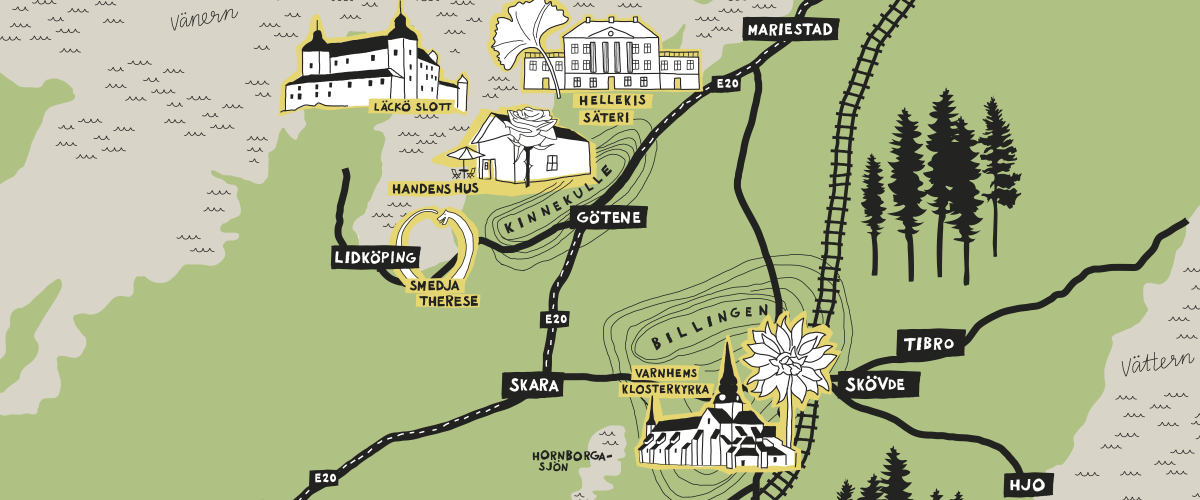Garden journey around Skaraborg, in Platåbergens Geopark
Here’s a recommendation for a road trip to lovely gardens around castles and estates in Skaraborg. Between the gardens you’ll find lots of great places to stop, including historic gems, table mountains, cafes, farm shops, craft galleries and cosy accommodation.
Road tip facts
Length: 2-4 days
Recommended period: Spring to early autumn
Remember to: Check opening times before your visit
This is the ideal road trip for anyone who finds it hard to make their mind up when planning a holiday, because it has the perfect mix of experiences. Taking centre stage are the gardens, which are surrounded by magnificent castles, abbey ruins, manor houses and country estates. Along the way you’ll pass unique home décor shops, historic remains, spa hotels, garden cafes, and restaurants. Everything is set in the Platåbergens Geopark, with its fantastic scenery and incredible views. Naturally you can decide which way round you want to do the trip yourself!
Garden 1 –The Walled Castle Garden at Läckö Castle
We start our road trip furthest out on Kållandsö north of Lidköping, where the majestic Läckö Castle towers up like something out of a fairytale. On one side of the castle is the unbroken vista of Lake Vänern and on the other you’ll find the Walled Castle Garden framed by high white stone walls.
Behind the walls awaits an oasis of crops and greenery. Head gardener Simon Irvine worked to make the kitchen garden into a special place for over 30 years and it is still maintained in the same spirit after his retirement. Gardening is all done organically and everything edible goes to the kitchen to be made into something as soon as it is harvested. It’s locally grown in its purest form.
“Nothing is left to chance. The earth is carefully turned by hand by skilled gardeners and when autumn arrives garden waste is piled up under the walnut tree to compost.”
You can wander round admiring the garden for a long time here, before heading over to Café Stallet or Victoriahuset for a fika. Naturally we also really recommend making time for a guided visit of the castle if you can.
There’s plenty more to see round Läckö Castle.
- Naturum Vänerskärgården – Victoriahuset is situated right by Läckö Castle. As well as visiting this nature centre to learn about Lake Vänern and the Djurö national park you can also stay the night here. The building has won awards for its nature inspired architecture.
- Läckö Strand also offers lakeside accommodation, with a campsite, cabins and a café.
- If you want to try some Vänerlöjrom vendace roe, one of the few Swedish products with a Protected Designation of Origin, we can recommend Restaurang Sjöboden in the pretty Spiken fishing harbour.
Photographer: Jonas Ingman
Stop off in porcelain town Lidköping
It’s time to head off to the next garden. On the way you’ll pass Lidköping which is famous for its porcelain history.
- A guided tour at Rörstrand Museum will take you through the history of Swedish porcelain, from 1726 to today. And while you’re there you can enjoy a coffee served in finest Rörstrand porcelain, in the museum café.
- Just south of Lidköping lies Resville Mathantverk, whose products you might have seen before in the shops. Mooch around the farm shop for jams, cordials, sauces and oils, among other things, and treat yourself to a cake in the café.
Garden 2 – Smedja Therese, the Garden of Possibilities and Sculpture Park Ouroboros
Welcome to a garden where there are always exciting things happening, which is reflected in the name. You’ll find the Garden of Possibilities, combined with Sculpture Park Ouroboros and Smedja Therese’s smithy at the foot of Kinnekulle table mountain.
“It’s a real adventure wandering around the rockeries, flower beds and sculptures – you never know what you’re going to discover next!”
The garden has an “English cottage” character and is divided into several different green rooms, where beautiful oaks and fruit trees are interspersed with berry bushes and perennials. You can even come across poisonous and magical herbs in this large 7000 m² plot. There’s also a garden pavilion, several rockeries, a small greenhouse and the opportunity to buy home baked fika.
The sculptures in the park come from local creators and artists. Book a visit to the smithy to have a look at all the lovely metal artwork.
- If you didn’t quite fika enough at Smedja Therese then you can pop into Café på Klostret on the way to the next garden.
Garden 3 – Handens Hus
The first thing you notice when you arrive at Handens Hus is the pretty stone barn, reminiscent of the fishing sheds on the island of Öland’s stony coast. One gable is covered with rose bushes that have gone wild and on the other side the outside furniture is ready and waiting for guests wanting a cup of coffee.
“Everything is exactly as picturesque as you would want from a garden destination.”
The garden itself isn’t the biggest you will have seen, but there’s a lot to be inspired by. In the borders you’ll find everything from lavender and mallow to orpine and day lilies. And there are lots of nice details in the form of decorated pots, iron sculptures and antique garden ornaments.
Inside the stone barn is a weaving studio with vintage Swedish everyday objects. And of course you can also buy lots of lovely garden bits and pieces.
Lots to explore on Kinnekulle
Make sure you save some time to explore more of Kinnekulle’s nature and history. There are so many exciting places, including the Stora Stenbrottet quarry, the Munkängarna nature reserve, a mountain cave - Lasses Grotta, and several medieval churches and charming station houses.
Photographer: Fedja Salihbasic
Garden 4 – Hellekis Säteri
If you continue north along Kinnekulle’s flank it’s not long until you reach the next green oasis. In 1746 Hellekis Säteri was mentioned by the father of taxonomy, Carl Linnaeus, during his trip through Västergötland. Throughout history the place has been known for its beauty as well as its tranquillity.
Kinnekulle’s lime rich soils, as well as the Säteri’s favourable position on the western slopes facing Lake Vänern, provide a growing climate that even enables the cultivation of exotic plants. There’s a beautifully scented rose garden with old fashioned roses here, and in early summer the pink poppies are in full bloom.
“The Säteri’s parkland has become known for its many and unusual deciduous trees, like walnut, sweet chestnut, cucumber tree and two majestic ginkgo trees.”
There’s a lot to stroll around and look at, and as there’s a restaurant you can easily stay a bit longer and have something to eat. It’s situated in the former orangery and we recommend you try the wild garlic soup if it’s in season, a local classic.
Spend a night surrounded by art and history
Now it’s time to leave Kinnekulle and head south to Varnhem, on Mount Billingen’s western flank. It might also be a good point to stop for the night, so here are some suggestions.
- In the middle of Vallebygden’s glorious countryside you’ll find Fredriksons Vilt, Vin & Pensionat, where you can stay in cosy rooms and eat well made food with ingredients provided by local farmers, fishers and from their own kitchen garden.
- If you want a touch more luxury we recommend a lovely spa treatment and dinner at Lundsbrunn Resort & Spa, which has several pools, a spa bath, sauna and solarium.
- Skara Stadshotell is a historic hotel in the heart of Skara. The hotel has a restaurant and has been stylishly renovated with many beautiful details.
- Anders Zorn, Carl Larsson and Bruno Liljefors are some of the artists whose original work can be admired in the art gallery at Skara Konsthotell. Combine it with dinner, gym and relaxation.
- The 600 year old bishop’s palace outside Skara now houses both a hotel, apartments and a B&B. Brunsbo Gästgifveri has accommodation for all tastes and a lovely restaurant as well.
Photographer: Skara Konsthotell
Garden 5 – The dahlia borders in Varnhem
In some ways time has stood still in the little village of Varnhem outside Skara, and yet new things happen there all the time. The medieval abbey, with its well preserved abbey ruins, is one of West Sweden’s most visited historic monuments. The area has recently been enriched by the addition of the Kata Gård exhibition, the Klostersjön Trail has been restored and a collection of dahlias has been planted.
The dahlia borders in Varnhem are by the entrance to the abbey area, neighbouring the abbey café. When they are in flower you can see around 70 different kinds of dahlias here in a fantastic colour cascade.
“Did you know that the flower was called Dahlia after the Swedish botanist Andreas Dahl (1751-1789) who was born right here in Varnhem?”
Alongside the abbey ruins is the Herb Garden, where a selection of the monks’ medicinal plants are grown, and the Rose Path winds round the whole site. This two kilometre long walking trail takes you past lovely rose borders, limestone steps and a lovely old stone bridge. For anyone wanting to do more walking we can also recommend the Pilgrim Path stretching between Varnhem and Falköping.
The perfect spot for a little detour
You’ll now find yourself in Skaraborg’s heartland, and whichever way you turn natural, cultural and historical gems await. To the north lies Vallebygden with its gentle hills and stunning cherry blossom. To the west is Skara with its museums and antique shops. Billingen is in the east, with nature experiences for the whole family. And going south you’ll find Lake Hornborga with its rich birdlife, which is the direction our roadtrip is now heading.
Some tips for places to stop on the way to the next garden.
- When did you last eat a galette? At Mellomgården Café & Gårdsbutik you can swing by for a real teatime treat, with freshly made galettes which are like a cross between thin crêpes and traditional pancakes. There’s also a great farm shop, and cottages for overnight stays.
- Right next to the Lake Hornborga naturum nature centre is Café Doppingen. This lovely café is housed in a building inspired by local barns, with a thatched roof. Sip a coffee while you admire the view of the lake.
- Löfwings Ateljé och Krog is a bit like a gilt edged Kinder egg. On the pretty farm artist Göran Löfwing and his wife and chef Linda run a gallery, studio, B&B, shop, café and restaurant.
- At Kdesign you can fika or have a light lunch then shop for home décor, design objects, plants, pots, lamps and everything in between.
- The living museum Åsle Tå contains Sweden’s largest remaining collection of crofts, called backstugor in Swedish. Walk down picturesque Tågatan street and peep into the tiny cottages. There’s also a café.
Photographer: Mårten Bergkvist
Cheese and spas, what a combo!
We know, it’s perhaps not the most usual combination, cheese and spas, but the fact is that these are two of the things that Falköping is best known for. The town is also associated with its table mountains, Mösseberg and Ålleberg, which are real playgrounds for nature lovers.
- Vilhelmsro Gårdscafé is surprisingly close to the centre of Falköping, considering it’s a farm. They make all their own food from scratch here using genuine ingredients and concerts are held often in the old stables, these days the dining room.
- People have been coming to Mössebergs Kurort for over a century now, to stay, eat well and relax. Warm pools, outdoor hot springs, foot baths and steam saunas are just some of the spa experiences here.
- Hotell Falköping is a classic town centre hotel with a lovely homelike atmosphere. No complications, just pleasant accommodation close to everything in town.
- And so we get to the cheese. Falbygdens Osteria is a paradise for anyone who can’t get enough of cheese in all its variety. The shop has over 150 kinds of cheese and there’s always something tasty on the menu in the restaurant.
Garden 6 – Alphems Arboretum
We’ve arrived at the road trip’s last garden, and hold on to your hats because awaiting you is a rarely seen collection of trees and a house that inspired Disney himself. You don’t want to miss that!
It all started in 1903 when rural postman Frans Johan Gegerfeldt moved with his wife to Alphem. He then spent the next 50 years planting rare trees and bushes from all over the world, building stone walls and grottos – he even constructed his own ‘alp top’ right by the cottage. He got his plants from Swedish and foreign nurseries, often in exchange for seeds from his tree collection.
“During his lifetime Gegerfeldt managed to wear out no less than eleven wheelbarrows. Keep that in mind next time you’re pottering around the garden at home!”
Today there are 300 different trees and bushes at Alphems Arboretum, and you can read about the different varieties on signs placed around the large garden. The arboretum is open for visits all year round and you can book guided tours. In summer the café is open.
By now you’re probably dying to know what Disney had to do with Alphem. Well the dwarfs’ cottage in the Snow White film is said to be modelled on the Gegerfeldts’ picturesque cottage. Not so hard to understand when you see how charming the cottage and its garden are!
Platåbergens Geopark – the first in Sweden
As you might have noticed, there’s a lot to discover and do in Skaraborg. As well as the gardens and all the cosy cafes and accommodation we’ve written about, nature itself is a sight to see. In 2022 the area became chosen as Sweden’s first Unesco global geopark. Platåbergens Geopark consists of 15 different table mountains and is filled to the brim with exciting stories about how the planet developed and mankind’s history.
You’ll find several ancient remains in the area. Some of the best known are Ekornavallen, the Amundtorp stone ship, Skalundahögen and the Flyhov rock carvings.
On the gardens pages you’ll find more tips and guides to gardens you shouldn’t miss, cosy garden cafes and floral destinations to visit.
Road tip facts
Length: 2-4 days
Recommended period: Spring to early autumn
Remember to: Check opening times before your visit










